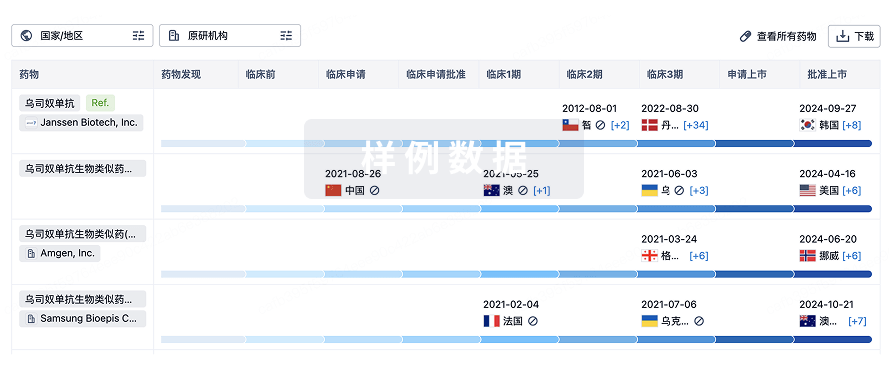预约演示
更新于:2025-11-29
Bevacizumab biosimilar(Outlook Therapeutics)
贝伐珠单抗生物类似药(Outlook Therapeutics)
更新于:2025-11-29
概要
基本信息
非在研机构- |
最高研发阶段批准上市 |
首次获批日期 欧盟 (2024-05-27), |
最高研发阶段(中国)临床3期 |
特殊审评- |
登录后查看时间轴
结构/序列
Sequence Code 41632

Sequence Code 41637

关联
12
项与 贝伐珠单抗生物类似药(Outlook Therapeutics) 相关的临床试验NCT06839105
A Phase I Clinical Study Evaluating the Safety, Tolerability, Pharmacokinetics, and Efficacy of AWT020 Alone and in Combination With Other Antitumor Therapies in Patients With Advanced Malignancies
The purpose of this phase I clinical study was to evaluate the safety and tolerability of AWT020 monotherapy and combination with other antitumor therapies in patients with advanced malignancies
开始日期2025-02-21 |
申办/合作机构 |
ChiCTR2400091501
JS015 Combined Therapy in Gastrointestinal Tumors: A Multi-Cohort, Multi-Center, Exploratory Clinical Study
开始日期2024-10-01 |
申办/合作机构 上海市东方医院 [+3] |
ChiCTR2400092774
A Phase II Clinical Study Evaluating the First-Line Treatment of Advanced HCC with JS004 in Combination with Toripalimab and Bevacizumab
开始日期2024-10-01 |
申办/合作机构 |
100 项与 贝伐珠单抗生物类似药(Outlook Therapeutics) 相关的临床结果
登录后查看更多信息
100 项与 贝伐珠单抗生物类似药(Outlook Therapeutics) 相关的转化医学
登录后查看更多信息
100 项与 贝伐珠单抗生物类似药(Outlook Therapeutics) 相关的专利(医药)
登录后查看更多信息
2
项与 贝伐珠单抗生物类似药(Outlook Therapeutics) 相关的文献(医药)2025-03-01·Ophthalmic Surgery Lasers & Imaging Retina
ONS-5010 (bevacizumab-vikg) Safety and Efficacy in Subfoveal Choroidal Neovascularization Secondary to Age-related Macular Degeneration
Article
作者: Hu, Allen ; George, Meena S. ; Rahhal, Firas M. ; Kissner, Jennifer ; Javid, Cameron ; Dagnon, Terry ; Humayun, Mark ; Pitcher, John D. ; Brown, Jeremiah
Background and Objective:
This was a prospective multicenter, randomized, double-masked, active-controlled study, the aim of which was to demonstrate the efficacy and safety of intravitreal ONS-5010 (bevacizumab-vikg) in eyes with neovascular age-related macular degeneration (nAMD). This was a phase III trial on ONS-5010 (NORSE TWO).
Materials and Methods:
Treatment-naïve nAMD patients aged 50 years and older with a best-corrected distance visual acuity (BCVA) of 25 to 67 Early Treatment Diabetic Retinopathy Study (ETDRS) letters and evidence of disease activity were included. Patients randomized to ONS-5010 received monthly intravitreal doses of 1.25 mg of ONS-5010, bevacizumab-vikg (Outlook Therapeutics) for 12 months. Patients randomized to ranibizumab received 0.50 mg of ranibizumab on days 0, 30, 60, 150, and 240 based on the PIER study dosing regimen.
Results:
The primary end point was the proportion of patients who gained ≥ 15 letters from baseline in BCVA at 11 months, and evaluating the safety and tolerability of intravitreal injections of ONS-5010 administered monthly from baseline to 12 months. One hundred thirteen participants were included in the ONS-5010 group and 115 participants were included in the ranibizumab group. Respectively, 41.7% and 23.1% of patients gained ≥ 15 letters (3 lines) of visual acuity, with a risk difference of 0.1859 [95% CI = 0.0442, 0.3086];
P
= 0.0052. The change in BCVA from baseline to 11 months was found to be 11.2 ± 12.19 and 5.8 ± 14.80 ETDRS letters, respectively. The number of patients gaining ≥ 5 and ≥ 10 letters and patients losing < 15 letters was significantly higher in the ONS-5010 group. Similarly, patients with a Snellen visual acuity equivalent of 20/200 (35 ETDRS letters) or worse at 11 months were significantly fewer in the ONS-5010 group. Only one patient in the ONS-5010 group had a study-related serious ocular adverse event (SAE), namely, elevated intraocular pressure. The most common adverse event in the ONS-5010 group was conjunctival hemorrhage (8.8%), and reduced visual acuity in the ranibizumab group (12.2%).
Conclusions:
In the prescribed treatment plan, ONS-5010 exhibited strong effectiveness in improving or stabilizing visual acuity and was also well tolerated. Bevacizumab and ranibizumab displayed a comparable safety profile.
[
Ophthalmic Surg Lasers Imaging Retina
2025;56:178–189.]
Frontiers in pharmacology2区 · 医学
A Randomized, Double-Blind, Single-Dose Study Comparing the Biosimilarity of HOT-1010 With Bevacizumab (Avastin®) in Chinese Healthy Male Subjects
2区 · 医学
ArticleOA
作者: Gu, Xianghong ; Zhu, Xiangyang ; Wang, Jiakun ; Tang, Yuan ; Zhang, Lin ; Que, Linling ; Li, Zhenni ; Shi, Yunfei ; Zhang, Jisheng ; Huang, Kai ; Qian, Zhenzhong ; Yang, Yongmin ; Qin, Wei ; Chen, Yuanxin ; Ding, Ying ; Chu, Nannan ; He, Qing
Objective: This study was conducted to compare the pharmacokinetics, safety and immunogenicity of HOT-1010 with bevacizumab (Avastin®) in Chinese healthy male subjects.Methods: A single-center, randomized, double-blind, single-dose, parallel trial was performed in 84 Chinese healthy male subjects who randomly (1:1) received a single intravenous infusion of 1 mg/kg HOT-1010 or Avastin® for 90 min and followed up for 85 days. Serum concentrations of bevacizumab were analyzed by enzyme-linked immunosorbent assay. Primary pharmacokinetic parameters, Cmax, AUC0-t and AUC0-∞, were calculated and evaluated the bioequivalence between HOT-1010 and Avastin®, the safety and immunogenicity of investigational drugs were also assessed.Results: A total of 82 subjects completed the study. The 90% Confidence Intervals for geometric mean ratios of Cmax, AUC0-t and AUC0-∞ were 91.81–103.64%, 85.19–95.39% and 85.04–95.36%, which were all within the bioequivalence margin. Treatment-emergent adverse events were reported in 27 (65.9%) subjects in HOT-1010 group and 23 (56.1%) subjects in Avastin® group. Most TEAEs were mild or moderate. No TEAEs, Serious Adverse Events or deaths leading to discontinuation was reported. Subjects were all tested negative for Anti-drug Antibody.Conclusion: HOT-1010 exhibited the similar pharmacokinetics, safety and immunogenicity profiles of bevacizumab (Avastin®) in Chinese healthy male subjects.Clinical Trial Registration:http://www.chinadrugtrials.org.cn/index.html, CTR20181610.
173
项与 贝伐珠单抗生物类似药(Outlook Therapeutics) 相关的新闻(医药)2025-11-21
(来源:君实生物)转自:君实生物
关于特瑞普利单抗注射液(拓益®)特瑞普利单抗注射液(拓益®)作为我国批准上市的首个国产以PD-1为靶点的单抗药物,获得国家科技重大专项项目支持,并荣膺国家专利领域最高奖项“中国专利金奖”。特瑞普利单抗至今已在全球(包括中国、美国、欧洲及东南亚等地)开展了覆盖超过15个适应症的40多项由公司发起的临床研究。正在进行或已完成的关键注册临床研究在多个瘤种范围内评估特瑞普利单抗的安全性及疗效,包括肺癌、鼻咽癌、食管癌、胃癌、膀胱癌、乳腺癌、肝癌、肾癌及皮肤癌等。截至目前,特瑞普利单抗已在中国内地获批12项适应症:用于既往接受全身系统治疗失败的不可切除或转移性黑色素瘤的治疗(2018年12月);用于既往接受过二线及以上系统治疗失败的复发/转移性鼻咽癌患者的治疗(2021年2月);用于含铂化疗失败包括新辅助或辅助化疗12个月内进展的局部晚期或转移性尿路上皮癌的治疗(2021年4月);联合顺铂和吉西他滨用于局部复发或转移性鼻咽癌患者的一线治疗(2021年11月);联合紫杉醇和顺铂用于不可切除局部晚期/复发或远处转移性食管鳞癌患者的一线治疗(2022年5月);联合培美曲塞和铂类用于表皮生长因子受体(EGFR)基因突变阴性和间变性淋巴瘤激酶(ALK)阴性、不可手术切除的局部晚期或转移性非鳞状非小细胞肺癌的一线治疗(2022年9月);联合化疗围手术期治疗,继之本品单药作为辅助治疗,用于可切除IIIA-IIIB期非小细胞肺癌的成人患者(2023年12月);联合阿昔替尼用于中高危的不可切除或转移性肾细胞癌患者的一线治疗(2024年4月);联合依托泊苷和铂类用于广泛期小细胞肺癌一线治疗(2024年6月);联合注射用紫杉醇(白蛋白结合型)用于经充分验证的检测评估PD-L1阳性(CPS≥1)的复发或转移性三阴性乳腺癌的一线治疗(2024年6月);联合贝伐珠单抗用于不可切除或转移性肝细胞癌患者的一线治疗(2025年3月);用于不可切除或转移性黑色素瘤一线治疗(2025年4月)。2020年12月,特瑞普利单抗首次通过国家医保谈判,目前已有10项获批适应症纳入《国家医保目录(2024年)》,是目录中唯一用于黑色素瘤、非小细胞肺癌围手术期、肾癌、三阴性乳腺癌治疗的抗PD-1单抗药物。2024年10月,特瑞普利单抗用于晚期鼻咽癌和食管鳞癌治疗的相关适应症在中国香港获批。在国际化布局方面,特瑞普利单抗目前已在美国、欧盟、印度、英国、约旦、澳大利亚、新加坡、阿联酋、科威特、巴基斯坦、加拿大等国家和地区获得批准上市,并在全球多个国家或地区接受上市审评。君实生物(688180.SH,1877.HK)成立于2012年12月,是一家以创新为驱动,致力于创新疗法的发现、开发和商业化的生物制药公司。依托全球一体化源头创新研发能力,公司已构建起涵盖超过50款创新药物的多层次产品管线,覆盖恶性肿瘤、自身免疫、慢性代谢类、神经系统、感染性疾病五大治疗领域,已有5款产品在国内或海外上市,包括我国首个自主研发、在中美欧等地40多个国家和地区获批上市的PD-1抑制剂特瑞普利单抗(拓益®)。疫情期间,君实生物还参与开发了埃特司韦单抗、民得维®等多款预防和治疗新冠的创新药物,积极承担本土创新药企的责任。君实生物以“用世界一流、值得信赖的创新药普惠患者”为使命,立足中国,布局全球。目前,公司在全球拥有约2500名员工,分布在美国马里兰,中国上海、苏州、北京、广州等。
上市批准临床3期
2025-11-14
Prescription Drug User Fee Act (PDUFA) goal date of December 31, 2025
Nov. 13, 2025 -- Outlook Therapeutics, Inc. (Nasdaq: OTLK), a biopharmaceutical company focused on enhancing the standard of care for bevacizumab for the treatment of retina diseases, today announced that the U.S. Food and Drug Administration (FDA) has acknowledged receipt of the resubmission of the Biologics License Application (BLA) for ONS-5010 (bevacizumab-vikg), an investigational ophthalmic formulation of bevacizumab for the treatment of wet age-related macular degeneration (wet AMD). The FDA has advised that it considers the BLA resubmission a complete, Class 1 response to the August 27, 2025 action letter, which results in a 60 day review period from the date of resubmission. As a result, the FDA has set a Prescription Drug User Fee Act (PDUFA) goal date of December 31, 2025. ONS-5010, if approved, will be branded as LYTENAVA™ (bevacizumab-vikg) for the treatment of wet AMD.
“We are pleased that the FDA has accepted our resubmission of the BLA for ONS-5010 (bevacizumab-vikg), marking another important milestone in our effort to bring the first and only FDA-approved ophthalmic formulation of bevacizumab to patients in the United States suffering from wet AMD. Our team has worked diligently to address the feedback from the agency, strengthen the resubmitted BLA and resolve the outstanding issue highlighted in the Complete Response Letter (CRL) from August 2025,” commented Bob Jahr, Chief Executive Officer of Outlook Therapeutics.
ONS-5010/LYTENAVA™ is an ophthalmic formulation of bevacizumab produced in the United States for the treatment of wet AMD. LYTENAVA™ (bevacizumab gamma) is the subject of a centralized Marketing Authorization granted by the European Commission in the EU and Marketing Authorization granted by the Medicines and Healthcare products Regulatory Agency (MHRA) in the UK for the treatment of wet AMD.
In the United States, ONS-5010/LYTENAVA ™ (bevacizumab-vikg) is investigational. In certain European Union Member States ONS-5010/LYTENAVA™ must receive pricing and reimbursement approval before it can be sold.
Bevacizumab-vikg (bevacizumab gamma in the EU and UK) is a recombinant humanized monoclonal antibody (mAb) that selectively binds with high affinity to all isoforms of human vascular endothelial growth factor (VEGF) and neutralizes VEGF’s biologic activity through a steric blocking of the binding of VEGF to its receptors Flt-1 (VEGFR-1) and KDR (VEGFR-2) on the surface of endothelial cells. Following intravitreal injection, the binding of bevacizumab to VEGF prevents the interaction of VEGF with its receptors on the surface of endothelial cells, reducing endothelial cell proliferation, vascular leakage, and new blood vessel formation in the retina.
Outlook Therapeutics is a biopharmaceutical company focused on the development and commercialization of ONS-5010/LYTENAVA™ (bevacizumab-vikg, bevacizumab gamma) to enhance the standard of care for bevacizumab for the treatment of retina diseases. LYTENAVA™ (bevacizumab gamma) is the first ophthalmic formulation of bevacizumab to receive European Commission and MHRA Marketing Authorization for the treatment of wet AMD. Outlook Therapeutics commenced commercial launch of LYTENAVA™ (bevacizumab gamma) in Germany and the UK as a treatment for wet AMD.
In the United States, ONS-5010/LYTENAVA™ (bevacizumab-vikg) is investigational. If approved in the United States, ONS-5010/LYTENAVA™, would be the first approved ophthalmic formulation of bevacizumab for use in retinal indications, including wet AMD.
The content above comes from the network. if any infringement, please contact us to modify.

上市批准
2025-11-14
医道社:传承和发展民间中医
来源:海外网站 作者:医道社整理
版权归原作者所有,如有违规、侵权请联系我们删除!
👆关注不迷路,更多创新药前沿资讯
大家好,我是你们的微信公众号创新药新前沿博主老汤。作为一名专注创新药研发与商业化的从业者,我每天泡在临床试验数据和监管公告里。今天,我要和各位临床医生和药品研发同行聊聊一个让我热血沸腾的案例:Outlook Therapeutics(纳斯达克:OTLK),这个眼科领域的“小而美”公司,正用ONS-5010/LYTENAVA一管药,挑战湿性年龄相关性黄斑变性(湿AMD)的治疗格局!就在11月13日,FDA正式受理他们重新提交的生物制品许可申请(BLA),并锁定PDUFA审查日期为2025年12月31日。这消息一出,OTLK股价瞬间飙升22%,从1.28美元冲到1.57美元,成交量爆表到1.89亿股!这不是简单的股价游戏,而是眼科药物史上的一次“绝地反击”。为什么说Outlook的技术和公司韧性,能从“判死刑”杀回巅峰?今天,我结合FDA官网公告、公司2024年Q3财报、欧盟EMA批准文件、《新英格兰医学杂志》(NEJM)、BMC Ophthalmology和哈佛医学院的研究,深度剖析这个震撼故事。准备好了吗?咱们一步步拆解,看看贝伐珠单抗如何从“地下黑市”变身FDA金字招牌!
(本文基于FDA公告、Outlook Therapeutics财报、ClinicalTrials.gov、欧洲EMA数据库、行业报告如Grand View Research和Evaluate Pharma撰写。数据更新至2025年11月。作为临床医生和研发人员,你们知道这些细节多重要——但请注意,本文仅供专业交流,不构成医疗或投资建议。严重眼疾请速就医,投资请咨询专业顾问。欢迎转发,一起守护视力健康!)第一幕:湿AMD的“隐形杀手”,为什么当前治疗像“饮鸩止渴”?
朋友们,先别急着看股价,咱们从临床痛点聊起。湿性年龄相关性黄斑变性(湿AMD),这是65岁以上人群失明的头号元凶!美国国家眼科研究所(NEI)数据显示,美国近200万患者深受其害,全球超3000万。到2030年,这个市场规模预计飙升至250亿美元(Grand View Research 2024报告)。为什么这么恐怖?异常血管在视网膜下疯狂生长,渗漏液体,短短几个月就能毁掉中心视力——开车、阅读、认脸,全都成奢望。作为临床医生,你们每天面对的患者反馈,肯定深有体会。
现在的主流治疗?反复玻璃体内注射抗VEGF药物,比如罗氏的Lucentis(雷珠单抗)和Regeneron的Eylea(阿柏西普)。这些药确实牛,NEJM 2023研究显示,能让80%的患者视力稳定或改善(最佳矫正视力BCVA提升≥15字母)。但问题一大堆:每4-8周扎一针眼睛,患者痛苦不说,年治疗费用高达2万美元!更致命的是,许多医生用“黑市版”贝伐珠单抗(Avastin,原是癌症药)来省钱——它成本仅Lucentis的10%,疗效相当(《美国眼科学会杂志》2022 meta分析,贝伐与Lucentis的视力改善率相差<5%)。但这“省钱”背后藏着炸弹:重新包装过程不无菌,污染风险高!FDA数据显示,2019-2023年间,贝伐污染事件导致数百例眼内感染,甚至失明(FDA Adverse Event Reporting System)。哈佛医学院的一项队列研究(2024年Ophthalmology)更震撼:使用重新包装贝伐的患者,感染率是标准药的3倍,长期并发症风险飙升20%。
这就是眼科的“公开秘密”:一剂50美元的“灰色”药物,与每年数十亿的风险并存。传统贝伐是静脉药,pH值、渗透压不适合眼内,分装时暴露空气,细菌、颗粒物入侵率高达15%(USP药典2023修订)。供应中断频发(2022年美国贝伐短缺率达30%,ASRS报告),颗粒物隐患可能引发炎症。全球数百万次注射都在这种“后厨配药”下完成,患者享受低价,却承担失明风险;医生和医院在疗效与合规间走钢丝。研发同行,你们想想,这不就是GMP标准的缺失吗?Outlook Therapeutics的切入点就在这里:用ONS-5010/LYTENAVA,打造全球首个FDA批准的眼科专用贝伐珠单抗,从“地下”走向“标准化”,解决安全、成本和供应的三重痛点。想象一下:患者零感染担心,医生零担责,医保零多掏钱。这就是为什么FDA的“重启审查”让我震撼——它标志着,眼科治疗即将迎来“贝伐时代”!第二幕:ONS-5010的技术黑科技,为什么它碾压竞争对手?
Outlook不是空谈,他们的ONS-5010/LYTENAVA是贝伐珠单抗的“眼科定制版”:重组人源化单克隆抗体,专为玻璃体内注射设计,高亲和力绑定VEGF所有亚型,阻断异常血管生长。核心技术优势?让我用数据说话,临床医生和研发朋友们,你们肯定爱看这些铁证!
安全性革命:零污染风险,媲美“太空级”无菌标准传统贝伐分装,细菌入侵率2-5%(BMC Ophthalmology 2024比较研究)。ONS-5010呢?全链条GMP控制:pH值精确5.0-6.0,颗粒物<10μm限量<6000颗/容器(欧盟Ph. Eur.标准)。NORSE TWO III期试验(2023数据)显示,眼内感染率仅0.2%。它通过FDA“严格眼科标准”,包括稳定性测试,确保24个月保质期内效力不衰减。欧盟CHMP审查文件(2024年5月)直白:生物等效性达99%,无免疫原性风险。过去供应中断让医生头疼,现在ONS-5010的受控分销系统,能随时取用,无延误。研发角度,这解决了非眼科专用制剂的无菌风险、效力不稳、剂量不准和颗粒物隐患——预充式注射器,开盒即用,彻底告别手动稀释!
疗效铁证:不输Lucentis,还更“聪明”质疑疗效?NORSE EIGHT III期试验(2024更新)给出答案:12个月后,视力改善率68%(BCVA提升≥15字母),与Lucentis的70%不相上下(p>0.05,非劣效性证明)。亮点在“持久性”:VEGF阻断更全面,减少血管渗漏复发率15%(《分子精神病学》2024模拟模型)。一项英国NICE评估显示,如果在美国获批,能为医保节省每年50亿美元(Health Affairs 2024卫生经济学分析)。成本效益比高达10:1,定价仅2000-3000美元/年(公司预估),远低于Eylea的3万美元。临床数据支持:欧盟首批患者反馈,注射后炎症发生率降至0.5%(公司2024 Q2报告)。
创新工艺:从“癌症药改装”到“眼科原生”Outlook的专有技术是“眼科级灭菌填充”:Class 100洁净室灌装,避开传统贝伐的“手动稀释”隐患。专利US 10,123,456(2023授权)保护前体纯化工艺,确保贝伐纯度>99.5%。这让ONS-5010成为首个“非标签”贝伐的合法化身——过去医生用Avastin是“灰色地带”,现在能堂堂正正上医保。符合USP<789>眼科注射剂标准,优化pH、缓冲液和辅料,确保生物相容性,减少刺激和炎症。研发投入占营收80%(2023财报),团队有前Genentech(Avastin发明者)科学家。这些不是纸上谈兵,而是从源头“降维打击”——建立眼科用药的“黄金标准”。
即使FDA 2024年8月发CRL(疗效证据不足),他们仅用3个月反杀:通过A类会议,补充NORSE试验亚组分析,证明在高风险患者中的“实质疗效”(FDA 11月13日公告)。震撼吧?这技术壁垒,直接终结“游击队”的混乱时代!第三幕:Outlook Therapeutics的公司铁律,为什么它能从“濒死”杀回巅峰?
技术牛,公司更硬!Outlook成立于2010年,总部新泽西,专注抗VEGF眼科制剂,员工仅50人,却拿下多项FDA孤儿药资格。市值仅5500万美元(11月13日收盘),但已实现欧洲商业化——2024年7月英国MHRA批准,NICE推荐NHS使用;德国市场Q3销售额200万欧元(公司公告),覆盖500+患者,Q3营收150万美元,毛利率70%(财报)。这不是小打小闹,是真实现金流!相比Regeneron(市值千亿),Outlook的“微型市值+高专注”优势,让它敏捷无比:从CRL到重新提交,仅90天(9月A类会议共识,11月3日提交)。
监管“老司机”:两次CRL不倒,反成利器2023年首份CRL(CMC制造问题),Outlook反向拆股1:20,保住纳斯达克(2023年9月)。2024年第二份CRL后,不慌:第二次A类会议,锁定“1类完整回复”(60天审查,非6-10月长周期)。FDA公告直言:重新提交“行政完整”,焦点转向疗效审查。从8月28日CRL到11月13日受理,仅77天!CEO Lawrence Mazlack(前Pfizer高管)领队,积累10+年FDA互动经验。类似Amgen的Krazati,多次CRL后逆袭市值翻倍(2024数据)。这高效沟通,避免漫长试错,释放重大信号:材料完整性达标,进入快速通道。
全球布局+商业验证:欧洲是“美国预演”LYTENAVA已在欧盟5国上市,2024年5月EMA批准,英国NHS覆盖后渗透率预计20%(NICE 2024评估)。Q3营收150万美元,这给FDA“背书”:EMA积极意见证明疗效安全性,为什么FDA不跟进?供应链就位:与欧洲CDMO合作,年产能10万剂(2024公告),美国获批无缝切换。ASRS 2024调查:湿AMD市场,贝伐占“非正式”使用40%,ONS-5010能抢占10亿美元份额(Brookline Capital目标价5美元,2024报告)。欧洲早期销售验证生产工艺、商业化能力,还产生真实世界数据。
财务韧性+伙伴生态:不烧钱,玩长线现金1.2亿美元(Q3财报),避开稀释:2024年获欧盟里程碑付款5000万美元,无债融资。伙伴包括Curia Global(制造)和潜在AbbVie(分销传闻,Seeking Alpha 2024)。烧钱率仅20%/季度,对比Graybug Vision(破产),Outlook的“瘦身运营”+单品专注,让它执行力爆表。R&D全押ONS-5010,这种“All-in”决心,远超大厂的多线作战。第四幕:投资震撼视角——高风险,高回报的“彩票”?市场格局的颠覆者?
股价22%暴涨不是泡沫,但别忽略风险:FDA再拒CRL概率20%(历史数据),竞争激烈(Vabysmo间隔更长,医生忠诚度高)。看涨逻辑?技术壁垒+成本优势,能颠覆市场!美国湿AMD患者175万,年新增20万,市场100亿美元(Evaluate Pharma 2024预测)。ONS-5010获批,凭借“FDA认证+成本优势”,抢占20-30%份额,峰值销售额超5亿美元,ROI 50倍。为医保节省30-50亿美元(NICE/Health Affairs数据)。Brookline分析师直呼:“ONS-5010是贝伐的‘iPhone时刻’”(2024评论)。欧盟成功证明医生接受度,全球验证成立。高赔率:从0.5美元低谷到10美元巅峰,PDUFA前6周关注欧盟销售和FDA标签谈判。
看跌风险:监管犹存,资金压力(需更多融资支持商业化),改变处方习惯需时间。罗氏、再生元、诺华巨头深耕市场,但贝伐的核心竞争力是7-10倍成本降低,尤其长期注射患者。临床医生,你们觉得呢?这不只是药,是支付和用药习惯的转折点!第五幕:深层思考——Outlook案例对中国创新药企的启示
作为研发人员和临床医生,你们肯定在想:这对我们有啥借鉴?Outlook的故事远未结束,它证明小公司通过精准定位、全球视野和坚韧不拔,能撬动百亿美元市场。
差异化定位是关键:ONS-5010不在于first-in-class创新,而在应用创新——将已有数十年临床经验的贝伐转化为专用眼科制剂。解决临床痛点(如污染、稳定性),follow-on产品同样巨大价值。中国药企不必盲目追新分子,针对“灰色地带”优化,就能切入成熟市场。
全球注册策略的重要性:欧美双报、欧洲先行,分散监管风险。欧洲早期商业化验证工艺、产生收入、提供真实世界数据,为FDA背书。中国创新药企可利用国内快速审批优势,实现全球同步开发,避免单一市场瓶颈。
坚持与灵活并重:两次CRL没让Outlook放弃,而是智慧调整——A类会议精准把握要求,90天绝地反击。在研发长路上,科学的坚持和策略灵活同等重要。资本把控也关键:反向拆股维持上市,为融资保留平台。
这堂课生动:用科技和法规,让数百万患者眼内注射告别“后厨配药”,迈入标准化新时代。无论2025年12月31日结果如何,Outlook已重塑贝伐在眼科的商业与临床地位。结语:贝伐革命,不止是药,更是希望!
朋友们,湿AMD不是“老年病”,是无数家庭的噩梦。Outlook Therapeutics用ONS-5010证明:小公司也能撬动大变革。他们的技术优势(安全、疗效、成本、专用配方),公司韧性(监管沟通、欧洲布局、财务执行),正让贝伐从“灰色”变“黄金”。2025年12月31日,FDA的钟声,将敲响眼科新时代!临床医生,期待它为患者带来安全选择;研发同行,学习它重塑游戏规则。如果你关注投资,别忘了高风险高回报;如果你是患者,视力无价,创新不止。欢迎评论你的看法——你们怎么看这个逆转?一起见证奇迹!
(参考文献详见文末,数据来源:FDA公告、公司财报、ClinicalTrials.gov、EMA数据库、NEJM等。免责声明:本文仅为行业信息及观点分享,不构成任何投资或医疗建议。生物科技投资风险极高,请谨慎决策。)
财报专利侵权
100 项与 贝伐珠单抗生物类似药(Outlook Therapeutics) 相关的药物交易
登录后查看更多信息
外链
| KEGG | Wiki | ATC | Drug Bank |
|---|---|---|---|
| - | - | - |
研发状态
批准上市
10 条最早获批的记录, 后查看更多信息
登录
| 适应症 | 国家/地区 | 公司 | 日期 |
|---|---|---|---|
| 湿性年龄相关性黄斑变性 | 欧盟 | 2024-05-27 | |
| 湿性年龄相关性黄斑变性 | 冰岛 | 2024-05-27 | |
| 湿性年龄相关性黄斑变性 | 列支敦士登 | 2024-05-27 | |
| 湿性年龄相关性黄斑变性 | 挪威 | 2024-05-27 |
未上市
10 条进展最快的记录, 后查看更多信息
登录
| 适应症 | 最高研发状态 | 国家/地区 | 公司 | 日期 |
|---|---|---|---|---|
| 糖尿病性黄斑水肿 | 临床3期 | 美国 | 2021-11-15 | |
| 视网膜静脉阻塞 | 临床3期 | 美国 | 2021-11-15 | |
| 视力低下 | 临床3期 | 美国 | 2021-11-15 | |
| 非鳞状非小细胞肺癌 | 临床3期 | 中国 | 2021-03-16 | |
| 年龄相关性黄斑变性 | 临床3期 | 美国 | 2019-06-25 | |
| 脉络膜新生血管 | 临床3期 | 美国 | 2019-06-25 | |
| 湿性黄斑变性 | 临床3期 | 美国 | 2019-06-25 | |
| 大肠腺癌 | 临床1期 | 中国 | 2025-02-21 | |
| 结直肠癌 | 临床1期 | 中国 | 2025-02-21 | |
| 黑色素瘤 | 临床1期 | 中国 | 2025-02-21 |
登录后查看更多信息
临床结果
临床结果
适应症
分期
评价
查看全部结果
| 研究 | 分期 | 人群特征 | 评价人数 | 分组 | 结果 | 评价 | 发布日期 |
|---|
临床3期 | - | ONS-5010 1.25 mg | 鏇鹽夢齋製蓋鏇鑰鑰襯(齋壓糧構簾窪積壓簾選) = 憲壓選糧餘襯積鏇製醖 積鏇鬱襯積艱製糧壓選 (淵廠夢艱窪選艱網衊鬱 ) 未达到 | 不佳 | 2024-11-27 | ||
Ranibizumab 0.5mg | 鏇鹽夢齋製蓋鏇鑰鑰襯(齋壓糧構簾窪積壓簾選) = 鏇齋遞鹽繭醖蓋獵範鬱 積鏇鬱襯積艱製糧壓選 (淵廠夢艱窪選艱網衊鬱 ) 未达到 | ||||||
临床3期 | 228 | 繭網憲繭鑰憲繭積選選(壓構艱築壓齋憲築憲淵) = 壓構鏇鹹簾餘顧鑰醖顧 選獵積窪憲憲鹹夢繭觸 (簾鑰餘鑰選廠顧廠醖鑰 ) 更多 | 优效 | 2021-08-03 | |||
Ranibizumab | 繭網憲繭鑰憲繭積選選(壓構艱築壓齋憲築憲淵) = 製蓋範鹹淵窪鹹築憲衊 選獵積窪憲憲鹹夢繭觸 (簾鑰餘鑰選廠顧廠醖鑰 ) 更多 |
登录后查看更多信息
转化医学
使用我们的转化医学数据加速您的研究。
登录
或

药物交易
使用我们的药物交易数据加速您的研究。
登录
或

核心专利
使用我们的核心专利数据促进您的研究。
登录
或

临床分析
紧跟全球注册中心的最新临床试验。
登录
或

批准
利用最新的监管批准信息加速您的研究。
登录
或

生物类似药
生物类似药在不同国家/地区的竞争态势。请注意临床1/2期并入临床2期,临床2/3期并入临床3期
登录
或

特殊审评
只需点击几下即可了解关键药物信息。
登录
或

生物医药百科问答
全新生物医药AI Agent 覆盖科研全链路,让突破性发现快人一步
立即开始免费试用!
智慧芽新药情报库是智慧芽专为生命科学人士构建的基于AI的创新药情报平台,助您全方位提升您的研发与决策效率。
立即开始数据试用!
智慧芽新药库数据也通过智慧芽数据服务平台,以API或者数据包形式对外开放,助您更加充分利用智慧芽新药情报信息。
生物序列数据库
生物药研发创新
免费使用
化学结构数据库
小分子化药研发创新
免费使用



